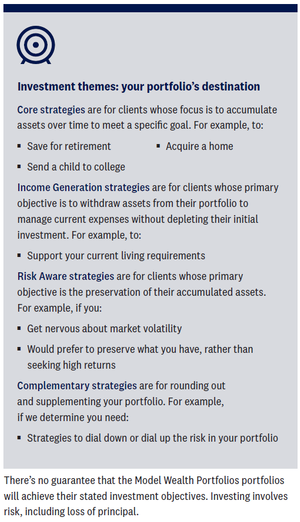Wealth Management
Investment Management Services
- Portfolio Review
- 401k / 403b Distribution Consulting
- Investment Selection
- Portfolio Rebalancing
- Tax Loss Harvesting
- Time Horizon Analysis
- Risk Tolerance / Risk Capacity Assessment
- Asset Allocation Analysis
- Investment Research
Our Process
I use a repeatable, thoughtful process to determine the right strategy for you and your objectives.
1. Clarify your goals and timeline
The first step in building your Model Wealth Portfolios strategy is determining your financial goals and when you want to accomplish them.
I’ll sit down with you to clarify what you hope to achieve from your investments, whether that’s saving for a child’s college education, working toward a large purchase, or planning for retirement. Together, we’ll establish goals that will guide my strategy decisions.
2. Determine your risk tolerance
Once we know what you hope to accomplish, the next step is figuring out how you feel about investing. I’ll spend time working with you to determine if you prefer a more conservative or aggressive approach, or somewhere in between.
3. Identify an investment style
Next, I’ll work with you to determine which investment style is best for your specific goals and current market conditions. The two primary investment-style options are strategic and tactical.
Strategic investing allows you to stay fully invested in a steady asset allocation model using a traditional buy-and-hold investment philosophy. Your asset allocation would be based on the manager’s long-term market outlook and wouldn’t change much due to market fluctuations.
Tactical investing attempts to take advantage of short-term market fluctuations to find opportunities for larger gains. In this case, your asset allocation would be based on a shorter time frame and change more often as a result of the market’s movements. Because more trading occurs in tactical investing, we’d have to consider the tax impact of this type of strategy. There’s a wide variety of tactical investment management styles, which we’ll discuss when it’s time to look at the models best suited for you.
I can also choose to combine strategic and tactical models if it makes sense for you and your objectives.
 4. Select your investment theme
4. Select your investment theme
The last major piece of the portfolio puzzle is your investment theme, which is the overall objective your portfolio will drive toward. Your goals, risk tolerance, and preferred investment style will help me determine the best theme for your portfolio. Model Wealth Portfolios portfolio themes are: core, income generation, risk aware, and complementary.
Your investment theme is the main objective I’ll work toward when building your portfolio, as well as the benchmark I’ll use to gauge the portfolio’s ongoing success. Rather than comparing your account’s performance with the financial markets, we’ll examine whether or not your portfolio is tracking with its stated goal. For example, if you and I collectively determine we’ll use a core investment theme—which has a goal of slowly growing your account over the long term rather than reaching for big spikes in account value in the short term—we’d expect to see a gradual increase in your account’s value. Even if the market has large increases, it wouldn’t make sense for your account to follow suit in this case.
5. Select or build strategies
These four puzzle pieces—goal, risk tolerance, style, and theme—are the foundational pieces I’ll use to narrow down the managers and models that will work for you.
I have the option to choose models primarily made up of exchange-traded funds or mutual funds, or separately managed accounts (SMA) strategies. Separately managed accounts have some similar features to a mutual fund, but allow you to own individual equities/securities and offer access to specific investment strategies, asset classes, or styles.
I will research the managers and models that fit with your preferences and objectives, and select those I think are appropriate for your situation and have tracked well with their stated account goals.
If I believe my own models would make more sense for you and match better with your goals than a manager model, I may use one of my own models (see the Advisor model build process to the left for more details on my approach).
Although one model may be most effective for you, I can also choose to combine multiple models to provide additional diversification and create the optimal portfolio for you. If you have any specific requests or needs that call for it, I can customize your portfolio further by adding models that focus on providing tax management, access to nontraditional investment strategies, additional income, or socially responsible investments. The end result will be a portfolio customized for you and designed to work toward your individual goals.
6. Set allocation
After I’ve selected the models I’ll be using in your portfolio, I’ll determine the percentage of your portfolio each model will represent. For example, if I use two models, one may represent 60% of your portfolio, and the other 40%. Within each of these models are diversified investments—so you get diversification on top of diversification.
There’s no guarantee that a diversified portfolio will enhance overall returns or outperform a nondiversified portfolio. Diversification doesn’t protect against market risk.
Investments
- Bonds
- Treasury Bills
- Government Securities
- Treasury Notes
- Common Stock
- Options
- Exchange Traded Funds (ETFs)
- Mutual Funds
- Unit Investment Trusts
- Cryptocurrency-Related Products
- SMAs, UMAs
- Alternative Investments
- Non-Traded REITs
- Non-Traded Business Development Companies (BDCs)
- Non-Traded Closed End Funds & Interval Funds
- Managed Futures
- Hedge Funds
- Private Equity and Credit
- Exchange Funds
- Real Estate Private Placements
- Qualified Opportunity Zone Funds
Accounts
- Fee-based
- Brokerage
- Custodial / UTMA / UGMA
- 401k, Solo 401k
- Cash Balance and Defined Benefit Plans
- Educational IRA
- Traditional IRA
- Roth IRA
- SEP IRA
- Simple IRA
Annuities
- Variable Annuity
- Fixed Annuity
- Indexed Annuity